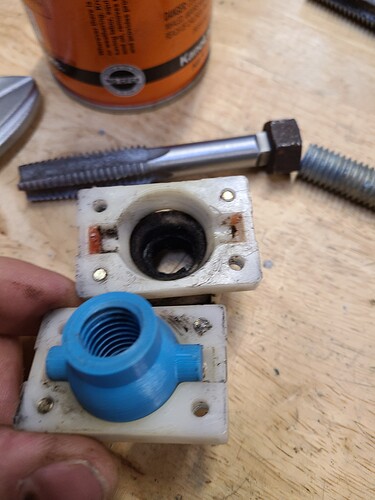Checking on an idea, to see if it could be a way out of Shapr3d’s basic limitations on tolerances. Say that I use a helix to build the bolt. That is easy.
Now, say that I build the female (nut) by subtraction. So far, I have a zero-tolerance match.
Now, in order to build the tolerance, I just offset all faces on the female by about half of the desired gross tolerance.
Would that work? Could it be that simple? Perhaps only some of the faces should be offset. Or offset different faces at different rates?
Cheers
OMG! I have been struggling over this very thing! (Perfect for “Off Topic” category!)
Seems to me they might mate and be fine or… you are in a few threads and then comes the friction!. And no go!
They guys who design the dies will likely be able to tell us.
I just posted about the same thing and saw this. I guess I’ll have to give this a go and see if it works. Either that or dust off Fusion 360.
Thanks
Depending on the tolerances you are shooting for the best solution I’ve found is to create the hole in the part the size of the actual tap drill size. I import a bolt from McMaster and modify it. Delete the flat on the major OD of the bolt to help create clearance. Install the modified bolt into the assembly and subtract. The last thing I do is to run a tap through for a minor cleanup and a good fit.
Do you mean this ?
I use this method and revolve it around.
The numbers for the minor and major here are p/8 and p/4 is the basic profile for threads
And for the how many turns
You use ( desired length / p)
If you multiply by 360 you will revolve it nicely.
Note: p stand for pitch
p/8 for nut threads
p/4 for screw threads
Another note : for 3D printers to print the threads nicely and accurate you have a minimum pitch to go for a Nozzle size.
Which you don’t want to get under
To add to @MrJack88 s comment and metric thread form, here are a few more standard thread forms from ages past Plus a bit of detail. I’ll search the book for correct tolerances.
Wow so much intells 
Thanks 
Are those gigantic screws and nuts?
From what I read it appears to.
Not exclusively. The diagrams are for screws of all sizes and are drawn as proportions rather than set sizes…
Some of the text is speaking of Whitworth threads - I believe it might have been the first standard thread. As whitworth sizes are in inches they would seem very big if taken as fractions of 1m. They are probably in thousandths of an inch.
Here is a response I made on a related thread.
Below is a Q&D model of a custom nut and bolt I created. I used a clearance suitable for prototyping via 3D printing.
-Mike
@milouchien The mentioned Buttress Thread 
Or close to. 
Yeah looks good!
I’m very pleased with the way Shapr revolves and allows elevation at the same time. Very useful for all kinds of difficult mathematical problems.
Is that what you did here?
Very neat work.
The thread form for both the nut and the bolt should be identical. Therefore it’s probably best to create one sketch and revolve it twice with a tolerance space in between. How I would do it below:
Draw single thread form sketch for the bolt at the edge of the bolt core as usual. Copy/move the sketch lines of the bolt thread form away on a horizontal axis only from the vertical centre axis of the bolt cylinder, and by the amount of tolerance desired.
Then copy the thread form part of the sketch above itself; this will make an accurate flipped version for the nut form between the two bolt forms. This reversed thread will now be at the correct height to revolve inside a hollow nut cylinder, with the same Z elevation as you will with the bolt.
This basically replicates the way threads are made in the real world. Thread form tooling and chasers etc are usually made the same shape for both nut and bolt - but with a tiny bit of extra metal taken off to allow them to fit together without interference.












